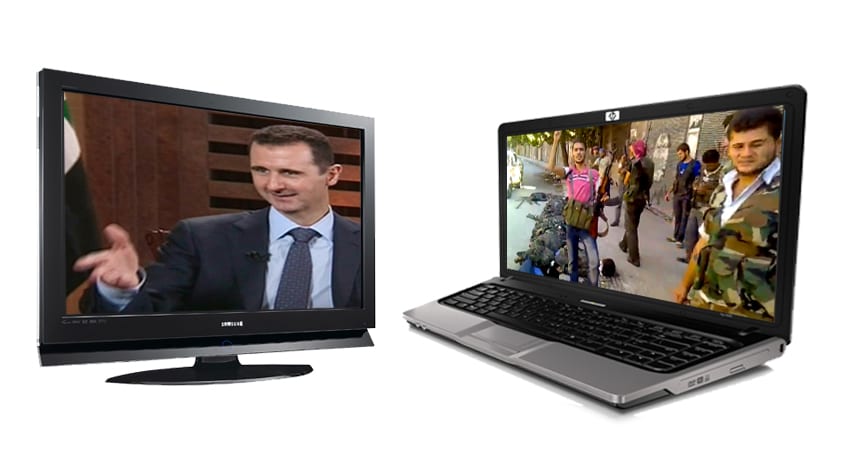
While many of the uprisings of the Arab Spring appear to be have transitioned from bloodshed in the streets to struggles within a political structure, the conflict in Syria endures. Neither President Bashar al Assad or the opposition appear to have charted a clear path to victory, and with the death toll climbing (according to activists) to more than 20,000, no clear path to the end is in sight. What a transition it has been from the early days of the uprising, when Syrian protestors gathered in largely peaceful protests in Damascus. Syria has seen a lot since those days – a violent crackdown, a gathering rebellion, a failed UN Peacekeeping mission, and multiple attempts from the outside world to intervene and stop the bloodshed.
But the fighting in Syria is not simply on the battlefield and in the streets: an equally important struggle is being waged in the realm of public perception.

(Source: Indiatelevision.com)
Back in June of 2012, NPR’s On The Media interviewed the BBC’s Paul Danahar on the evolving propaganda war within Syria. In the early days of the conflict, the regime was loath to allow reporters to catalogue the brutal crackdown that was taking place. Al Assad claimed that the opposition to his country was a mixture of Al Qaeda elements and foreign powers, and that his regime was all that stood between Syria and an extremist Islamist state. Few people took these claims seriously at the time, but over time, says Danahar, that narrative has become somewhat true.
“I think it’s become a bit of a self-fulfilling prophesy. He talked about there being Al Qaeda elements in Syria last year, and I think now there are Al Qaeda elements. So they’ve managed to worm their way into the structure of society because the society has become completely chaotic. His claim that the other governments are fiddling around in his back yard, they’re also true. He’s created the environment for the kinds of things he warned about happening to actually happen.”
It is correct that Al Qaeda and foreign fighters are taking part in the fighting. In many ways, Syria has now spiraled into the protracted civil war that everyone feared it would be. The rebellion – a fractured, disorganized collective of armed groups – has yet to provide the same sort of unified opposition that their counterparts achieved in Libya, and as a result, the deeds of individual factions are able to shift the narrative of the whole opposition. Images and videos of alleged mass executions of regime soldiers by the FSA have prompted a warning from the U.N. that the rebels are not immune from prosecution for atrocities.

President Al Assad’s goal in light of this is two-fold: to project his regime to both internal and external audiences as the inevitable, stable ruler of Syria, and to cast the opposition as a radical, unacceptable alternative. In some ways this objective is a continuation of the regime’s PR campaign before the uprising, in which Asma Al Assad, the president’s wife, received a glowing spread in Vogue magazine (recently dropped from the publication’s website).
(Source: Reuters)
Hassan Hassan of Foreign Policy documents his recent more recent PR offensive to carry the narrative – embedding journalists with Syrian forces fighting in Aleppo, highlighting captured foreign fighters and jihadists, and arranging television interviews to project confidence about the outcome of the conflict. The regime has met and given “positive commitments” to the Red Cross officials’ requests to address the humanitarian crisis, even as Syrian forces continue to shell civilian populations in Damascus and Aleppo.
By contrast, the opposition has failed to mount a similar imaging campaign, or anything close to it. Infighting and a lack of leadership in the Syrian National Council has made it very challenging for the organization direct the rebellion, much less combat the regime’s narrative with an effective counter campaign. As a result, says Michael Hughes of the Examiner, “the SNC’s poor media strategy and inconsistent messaging have allowed the Assad regime to frame the narrative.” Bassad Haddad laments the dysfunction of the opposition on display for all to see:
“We are no longer witnessing a clear-cut event where an independent pro-democracy movement is facing a dictatorship. Though the latter part holds, the former does not. The dependence, weakness, fragmentation, and divisiveness of the especially external opposition and its internal correlates are now evident to all.”
Skill with public relations doesn’t shift facts on the ground. No number of television interviews can banish the reality for Syrians of shelling and summary executions. But framing can shape the behavior of actors going forward. Perceptions of the regime’s inevitability and the opposition’s unacceptability may shift the behavior of ordinary Syrians as the battle for the country continues to play out. The belief by foreigners that the opposition is made up of radicals like Al Qaeda could stay the hand of powers with the ability to truly shift the winds in the opposition’s favor. Ultimately, If the opposition is to defeat the regime, they will need to do more than simply coordinate within the organization; they must also convince outsiders of their legitimacy and their ability to responsibly piece the country together.


